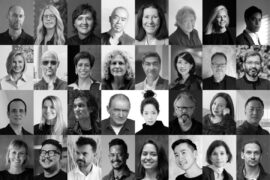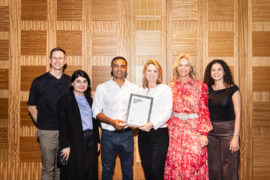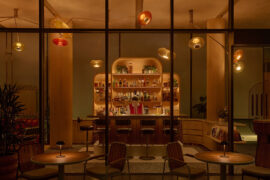How does a global design mega firm work? In Cubes 90, Nayan Parekh of Gensler Singapore shares some of the inner workings of one of the world’s most progressive workplace thought leaders.

Nayan Parekh photographed at the Gensler Singapore office. Portrait by Studio Periphery
February 21st, 2018
When building Cubes 90 on the theme of workplace, it would have been irresponsible not to pick the brain of Gensler. The US-founded firm is as old as Singapore and employs over 5,200 employees (and counting) worldwide. It remains one of the most profitable design practices with an expanding fleet of offices at a time when many are forced to shed some weight to keep their heads above the changing waters of our industry. And it is one of the most progressive thought leaders in the field of workplace design.
“It’s a time of unprecedented growth for us here in Singapore,” says Nayan Parekh, Gensler’s Singapore-based Senior Associate and firmwide Leader of its firm’s Consulting Practice Area. She continues, “One of the things we’ve needed to catch up on is how to keep people and culture alive when you’re growing so fast across the globe.”
There are over 400 employees of Gensler spread in eight studios across Asia, the biggest of which is the Shanghai studio. Together with the Beijing studio, it handles projects in China. Sister studios in Singapore and Bangkok work in tandem to cover the Southeast Asian region, while the Hong Kong studio covers projects locally.
Other big Gensler hubs in Asia are in Bangalore and Tokyo, which employ about 90 people each. The new kid on the block is the three-year-old, 20-strong Sydney studio, with New Zealand slated to be the next location.
Gensler invests heavily to keep its people connected and to nurture their passion. Its work is classified into three buckets – live, work, play – and each is further split into practice areas, which can either be sector specific or service specific. At the moment, globally the firm has 29 practice areas and each year it evaluates which ones are still meaningful to address the market and determine next year’s focus and investments. The last two years have been a golden age for consulting.
“One of the great things that comes from that structure is that we have practice area ‘call set ups’. Everyone is just a call away,” Parekh shares. She elaborates, “We get together to figure out what’s happening in the practice areas. And if tomorrow we have a client in New York who wants to know what’s happening in Singapore, the calls would have already equipped the team with that. We often know what’s happening faster than the clients.”
Read the complete article in Cubes 90 – on shelves now!
INDESIGN is on instagram
Follow @indesignlive
A searchable and comprehensive guide for specifying leading products and their suppliers
Keep up to date with the latest and greatest from our industry BFF's!
The new range features slabs with warm, earthy palettes that lend a sense of organic luxury to every space.

For Aidan Mawhinney, the secret ingredient to Living Edge’s success “comes down to people, product and place.” As the brand celebrates a significant 25-year milestone, it’s that commitment to authentic, sustainable design – and the people behind it all – that continues to anchor its legacy.

With the 2025 INDE.Awards now over, it’s time to take a breath before it all begins again in early December. However, integral to the awards this year and every year is the jury – and what an amazing group came together in 2025.

The Asia Pacific and Middle East regional leader for Gensler’s Digital Experience Design (DXD) practice discusses technology, AI, Scotland and the meaning of human-centred design in this episode of Stories Indesign.
The internet never sleeps! Here's the stuff you might have missed

The winners of two major Powerhouse design initiatives – the Holdmark Innovation Award and the Carl Nielsen Design Accelerator – have been announced with the launch of Sydney Design Week 2025.

The Standard, Singapore by Ministry of Design has been crowned winner of The Social Space at the INDE.Awards 2025. Redefining hospitality with a lush and immersive experience, The Standard celebrates both community and connection.